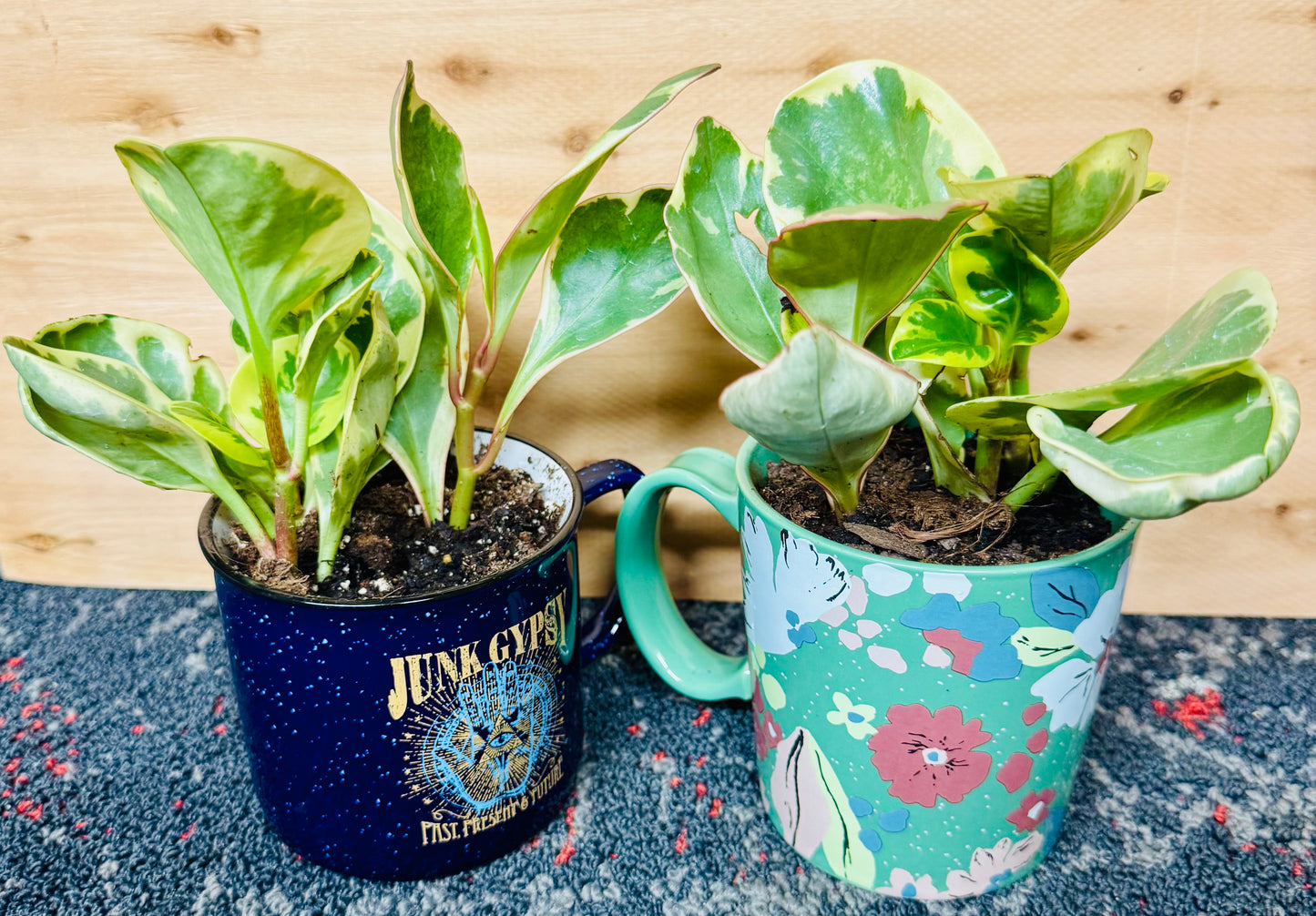Eden on Earth
6” Baby Rubber Plant Coffee Mugs
6” Baby Rubber Plant Coffee Mugs
Couldn't load pickup availability
6 inch Baby Rubber Plant Coffee Mugs
These baby rubber plants are potted in cute mug style planters. They have glossy leaves and a tidy upright form that fits any desk.
The Ultimate Guide to Baby Rubber Plant Care (Peperomia obtusifolia)
The Baby Rubber Plant, or Peperomia obtusifolia, is a wonderfully resilient and easy-to-care-for houseplant. Its thick, succulent-like, spoon-shaped leaves make it a favorite for beginners and seasoned plant enthusiasts alike. This guide will help you provide the best care for your Peperomia.
1. Understanding Your Plant
-
Scientific Name: Peperomia obtusifolia
-
Origin: Native to the tropical regions of Florida, Mexico, and the Caribbean. This tells us it appreciates warmth and moderate humidity but is also adapted to periods of dryness, thanks to its water-storing leaves.
-
Growth Habit: It has a compact, bushy, and slightly spreading growth habit. It is not a true rubber plant (Ficus elastica) and will remain relatively small, making it perfect for desks and shelves.
2. Core Care Requirements
💡 Light
-
Ideal: Bright, indirect light is best. It can thrive in a medium-light environment as well, making it quite versatile. An east- or west-facing window is excellent.
-
Too Little: In low light, the plant may become leggy and less vibrant. Variegated varieties may lose their distinct patterns.
-
Too Much: Avoid direct, intense sunlight, which can scorch the leaves and cause them to fade.
💧 Watering
-
Key to Success: The number one rule is do not overwater. Its succulent leaves store water, making it quite drought-tolerant.
-
When to Water: Allow the top 50% of the soil to dry out completely between waterings. For a 6-inch pot, this means the top 2-3 inches should be dry.
-
How to Water: Water thoroughly until it runs out of the drainage holes. Discard any excess water from the saucer. It's better to underwater this plant than to overwater it.
-
Frequency: Watering frequency will vary based on light and temperature, but it could be every 1-2 weeks.
🌱 Soil
-
Perfect Mix: An extremely well-draining soil is crucial.
-
Best Option: Use a mix formulated for cacti and succulents, or create your own by combining:
-
2 parts standard potting mix
-
1 part perlite or pumice
-
1 part orchid bark
-
-
-
Why it Works: This mixture ensures that the roots have plenty of air circulation and that water drains quickly, preventing the root rot to which this plant is susceptible.
🌡️ Temperature & Humidity
-
Temperature: Prefers average household temperatures between 65-75°F (18-24°C). Protect it from temperatures below 50°F (10°C).
-
Humidity: Average household humidity is perfectly fine. It doesn't require high humidity, but it won't be harmed by it either.
3. Growth and Maintenance
🌿 Fertilizing
-
Light Feeder: This plant does not require a lot of fertilizer.
-
What to Use: Feed with a balanced houseplant fertilizer diluted to half-strength.
-
How Often: Apply once a month during the spring and summer growing season. Do not fertilize in the fall and winter.
✂️ Pruning
-
Purpose: Pruning can help maintain its bushy shape and encourage fuller growth.
-
How to Do It: Use clean, sharp scissors to trim back leggy stems. You can prune it back to a desired shape or size at any time of year, but spring is ideal. The cuttings are very easy to propagate.
🪴 Repotting
-
Infrequent: Peperomia obtusifolia has a small root system and prefers to be slightly root-bound.
-
When: Repot only when it is clearly overgrown for its pot, typically every 2-3 years.
-
Choosing a Pot: Select a new pot that is only 1-2 inches wider in diameter. Ensure the new pot has excellent drainage.
4. Troubleshooting Common Issues
-
Drooping or Yellowing Leaves: This is almost always a sign of overwatering and potential root rot. Check the soil and allow it to dry out thoroughly.
-
Scab-like Bumps on Leaves: This is often caused by edema, a condition resulting from inconsistent watering. Try to maintain a more regular (but still infrequent) watering schedule.
-
Leaf Drop: Can be caused by sudden temperature changes, drafts, or severe over/underwatering.
-
Pests: Generally pest-resistant, but can occasionally get mealybugs or spider mites. Inspect the plant regularly.
⚠️ A Note on Toxicity
-
Great news! Peperomia obtusifolia is considered non-toxic to cats and dogs, making it a great pet-safe houseplant option.


